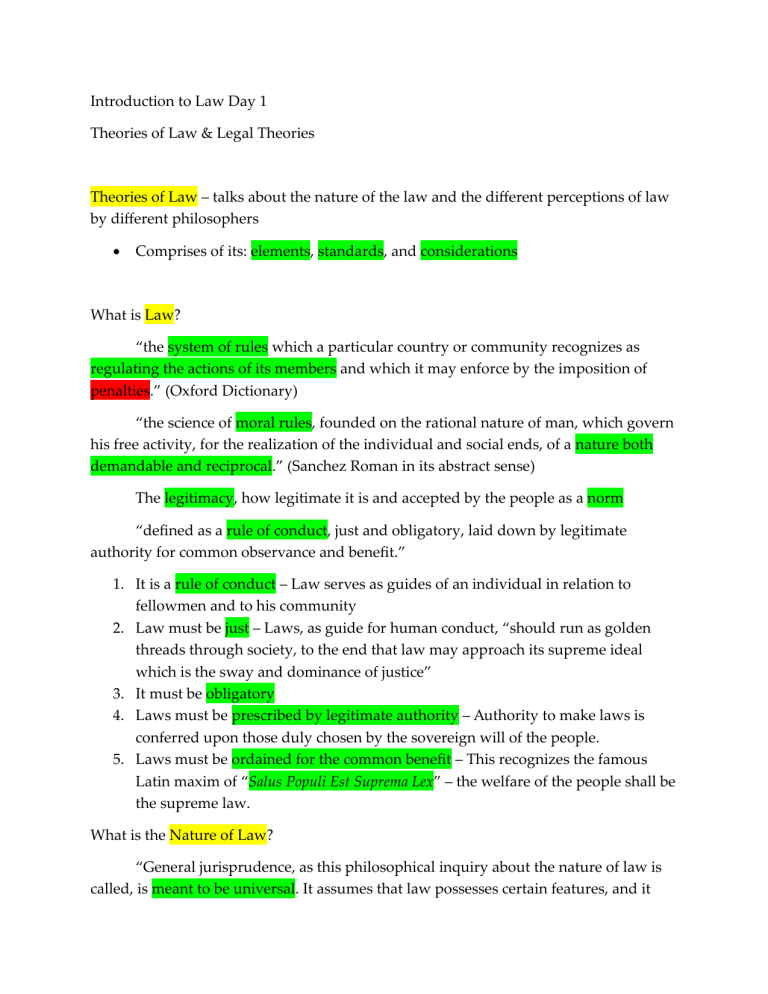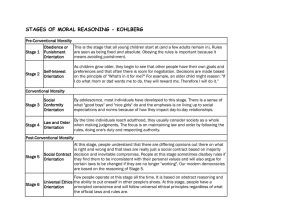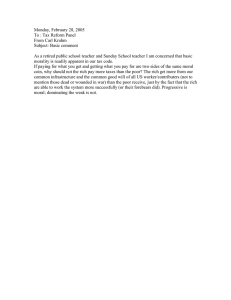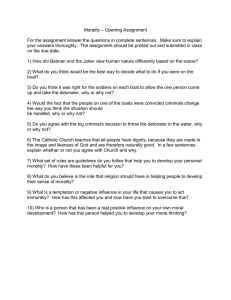
Introduction to Law Day 1 Theories of Law & Legal Theories Theories of Law – talks about the nature of the law and the different perceptions of law by different philosophers Comprises of its: elements, standards, and considerations What is Law? “the system of rules which a particular country or community recognizes as regulating the actions of its members and which it may enforce by the imposition of penalties.” (Oxford Dictionary) “the science of moral rules, founded on the rational nature of man, which govern his free activity, for the realization of the individual and social ends, of a nature both demandable and reciprocal.” (Sanchez Roman in its abstract sense) The legitimacy, how legitimate it is and accepted by the people as a norm “defined as a rule of conduct, just and obligatory, laid down by legitimate authority for common observance and benefit.” 1. It is a rule of conduct – Law serves as guides of an individual in relation to fellowmen and to his community 2. Law must be just – Laws, as guide for human conduct, “should run as golden threads through society, to the end that law may approach its supreme ideal which is the sway and dominance of justice” 3. It must be obligatory 4. Laws must be prescribed by legitimate authority – Authority to make laws is conferred upon those duly chosen by the sovereign will of the people. 5. Laws must be ordained for the common benefit – This recognizes the famous Latin maxim of “Salus Populi Est Suprema Lex” – the welfare of the people shall be the supreme law. What is the Nature of Law? “General jurisprudence, as this philosophical inquiry about the nature of law is called, is meant to be universal. It assumes that law possesses certain features, and it possesses them by its very nature, or essence, as law, whenever and wherever it happens to exist.” “This general question about the nature of law presupposes that law is a unique social-political phenomenon, with more or less universal characteristics that can be discerned through philosophical analysis.” “These two sources of interest in the nature of law are closely linked. Law is not the only normative domain in our culture; morality, religion, social conventions, etiquette, and so on, also guide human conduct in many ways which are similar to law. Therefore, part of what is involved in the understanding of the nature of law consists in an explanation of how law differs from these similar normative domains, how it interacts with them, and whether its intelligibility depends on such other normative orders, like morality or social conventions.” Legal or Judicial Reasoning Legal reasoning is the process of devising, reflecting on, or giving reasons for legal acts and decisions or justifications for speculative opinions about the meaning of law and its relevance to action. They suppose that reasoning can link up with action, guiding one what to do, or showing whether or not there are good reasons for a proposed course of action or for something already done. Judicial reasoning refers to the process by which judges arrive at a decision or judgment in a legal case. It involves the analysis and interpretation of the law, as well as the consideration of relevant facts and evidence presented in the case. It typically follows a structured approach, starting with an examination of the relevant legal principles and precedents that apply to the case. Judges will then consider the facts of the case, including any relevant evidence or testimony, considering these legal principles. Overlap thesis – overlap between law and morality Separability thesis – separation of law and morality Can Morality be Separated from Law? Natural Law Theory vs. Legal Positivism Natural laws derive their validity from moral order and reason and are based on what is believed to serve the best interests of the common good. It is also important to note that the moral standards that govern human behavior are derived to some extent from the inherent nature of the human beings and the nature of the world. In the perspective of natural law, good law is a law that reflects natural moral order through reason and experience. It is also important to understand the word moral here is not used in a religious sense, but it refers to the process of determining what is good and what is right based on reasoning and experience. Legal positivism holds the view that source of a law should be the establishment of that law by some socially recognized legal authority. It is also of the view that there is no connection between law and morals since moral judgments cannot be defended or established by rational arguments or evidence. Legal positivists consider good law as the law that is enacted by proper legal authorities, following the rules, procedures, and constraints of the legal system. Natural Law Theory Traditional: Validity of man-made laws is tested on the basis of some “higher law”, such as reason, morality, or divine law. Modern: Validity of man-made laws is tested on the basis of some “internal morality” Internal morality – found something within the law itself Moral standards – it is universal and unchanging (according to St. Thomas Aquinas) Legal Positivism Law is a “social fact or convention” There is no necessary connection between law and morality [Separability Thesis] Legal Realism Law – is a “body of dogma or systematized prediction” “The prophecies of what the courts will do in fact, and nothing more pretentious, are what I mean by the law” On “law” and “morality”: The Bad Man Theory (The law is what the bad man thinks it is) Bad Man Theory – is a legal doctrine that suggests that the view of the law held by a bad person is the best way to understand what the law actually is. This is because a bad person will carefully calculate what the rules allow and operate up to the limits of those rules. Major Legal Theories – applies the philosophy of the law and how judges also apply the law when they make legal reasoning. American Legal Realism A theory that all law derives from prevailing social interests and public policy. According to this theory, judges consider not only abstract rules, but also social interests and public policy when deciding a case. In this respect, legal realism differs from legal formalism. A “realistic” look at how judges decide cases, at “what the courts… do in fact” (O.W. Holmes, Jr.) Judges are influenced by more than legal rules; they decide cases according to “how the facts of the case strike them” Judges openly consider the policy implications of legal rules and decisions. (Brian Leiter) Law is in some point “rationally indeterminate” Indeterminate – Has not served its purpose yet Legal Formalism A theory that legal rules stand separate from other social and political institutions. According to this theory, once lawmakers produce rules, judges apply them to the facts of a case without regard to social interests and public policy. In this respect, legal formalism differs from legal realism. A positivist theory of law For a formalist, a law is already the product of normative and policy consideration in the formation of the law. Hence, a judge should not say what the law should be but should confine itself to what the law is. Constructivism aka Interpretivism – revolves around the spirit of the law Constructivism is carried out to establish the meaning of a certain practice, without indicating (or at least not indicating solely) the intentions attached to the practice by its author. The practice in itself is central, and the interpreter has to take into account the history and shape of the practice to see which interpretations of the practice are possible. Judges decide, not because it is what the law mandates, but because it is what is required by some standards of “morality” or “justice” that made up or formed the norm or law, the same standards that provide for the justification of the norm (although they are not found in the law) Introduction to Law Part 2 Kinds of Laws “The welfare of the people is the supreme law” Classification of Law: 1. Natural Law – this derives its force and authority from God. It is regarded to be superior to other laws and binding upon the whole world and in all countries. Physical law – universal rule of action that governs the conduct and movement of things which are non-free and material Moral Law – set of rules which establishes that is right and what is wrong as dictated by the human conscience Divine Law – Divine Positive Law (Ten Commandments) and Divine Human Positive Law (The Commandments of the Church) 2. Human Positive Law – is promulgated expressly or indirectly by competent human authority for the common good and usually but not necessarily imposing sanctions According to Force and Effect: 1. Mandatory and/or Prohibitory Laws – those which have to be complied with because they are expressive of public policy; disobedience is punished either by direct penalties or by considering and act or contract void. 2. Permissive or Suppletory Laws – those which may be deviated from, if the individual so desires According to Scope or Content of the law: 1. Public law – that which governs the relations of the individuals and with the State or rule or community as a whole This includes: Political Law, Criminal Law, and Law on Taxation 2. Private law – that which regulates the relations of the members of a community with one another This consists of: Civil Law, Labor Law, and Commercial Law According to whether a right is given or merely the procedure for enforcement is laid down: 1. Substantive law – that which establishes rights and duties and is enacted by the legislative department 2. Remedial (or Procedural or Adjective Law) – that which prescribes the manner of enforcing legal rights or claims It is not enacted by the Congress but by the Supreme Court of the Philippines Political Law That branch of public law which deals with the organization and operations of the governmental organs of the state and defines the relations of the state with the best inhabitants of the territory It consists among others of Constitutional Laws I & II (Bill of Rights and Due Process) Administrative Law, Law on Public Officers, & Election Laws Public International Law Good Written Constitution: Swimsuit Criminal Law That branch of law which defines offenses and specify the corresponding penalties therefor It consists among others of: Criminal Law I Criminal Law II Dolo – intentional offenses Culpa – unintentional offenses Taxation (A pervasive power in the sense that income of OFWs can still be derived from income tax) That branch of law which deals with the imposition and collection of taxes It consists, among others, of: Taxation I Taxation II Civil Law That branch of law which every particular notion or state has established peculiarly for itself. This law concerns with civil or private rights and remedies, as contrasted to criminal law. It consists, among others of: Persons and Family Relations Property Obligations & Contracts Succession Sales Credit Transactions Agency, Trust, and Partnership Torts & Damages Transportation Law Labor Laws That branch of law which deals with the relationship between the employer and the employees, as well as the working conditions, wages, fringe benefits, grievances, and association of employees It consists, among others, of: Labor Law I Labor Law II Commercial Law Body of law that applies to the rights, relations, and conduct of persons and business engaged in commerce, merchandising, and trade It consists, among others, of: Corporation Law Negotiable Instrument Law Remedial Law It refers to the means and methods of setting the courts in motion, making facts known to them and effectuating their judgements. It consists, among others, of: Civil Procedure Criminal Procedure Evidence Special Proceedings Introduction to Law Part 3 Sources of Law 1. Legislation – Upon the imposition of Martial Law and after the dissolution of old Congress, the power to legislate law is vested in the President of the Philippines. This is the reason why the President issued presidential decrees and letters of instructions. When the Batasang Pambansa was organized, legislative power is principally vested in this body although the President, under and by virtue of what is known as Amendment No. 6, continued to issue decrees when the exigency of the situation requires and in case of other emergencies. 2. Precedents – This means that the decisions or principles enunciated by a court of competent jurisdiction on a question of law do not only serve as guides but also as authority to be followed by all other courts of equal or inferior jurisdiction in all cases involving the same question until the same is overruled or reversed by a supreme court 3. Customs – Customs have the force of law only when they are acknowledged and approved by society through long and uninterrupted usage. In the Philippines, there are several requisites before the court considers custom. a. A custom must be proved as a fact according to the rules of evidence (Art. 12, NCC) b. The custom must not be contrary to law (Art. 11, NCC) c. There must be a number of repeated acts and these repeated acts must have been uniformly performed d. A custom must be acknowledged and approved by society through long and uninterrupted usage. 4. Court decisions – Judicial decisions which apply or interpret the Constitution and the laws are part of the legal system in the Philippines, but they are not laws. However, although judicial decisions are not laws, they are evidence of the meaning and interpretation of the laws. Legal Terms Authority or Power: Jurisdiction – I stand and speak by the law. It refers to the authority of a court to interpret the law or statute. It is conferred by the law Batas Pambansa bilang 129 – is a source of law Concurrent jurisdiction – two or more courts that has the power to adjudicate over a case or conflict (Must pass first in a barangay level) o Regional Trial Court, Court of Appeals, & Supreme Court Venue – the place where the case may be filed Local Government Code – is a source of law By authority – content: Primary authority o Mandatory primary authority – coming from the President o Persuasive mandatory authority – coming from other jurisdictions Secondary authority What is the effect upon courts? By source – who/what: Primary Source – comes from the government Secondary Source – it’s the opposite, non-government entities and agencies Printed vs. Electronic In case of conflict, which will prevail? Publication in Newspaper of General Circulation





